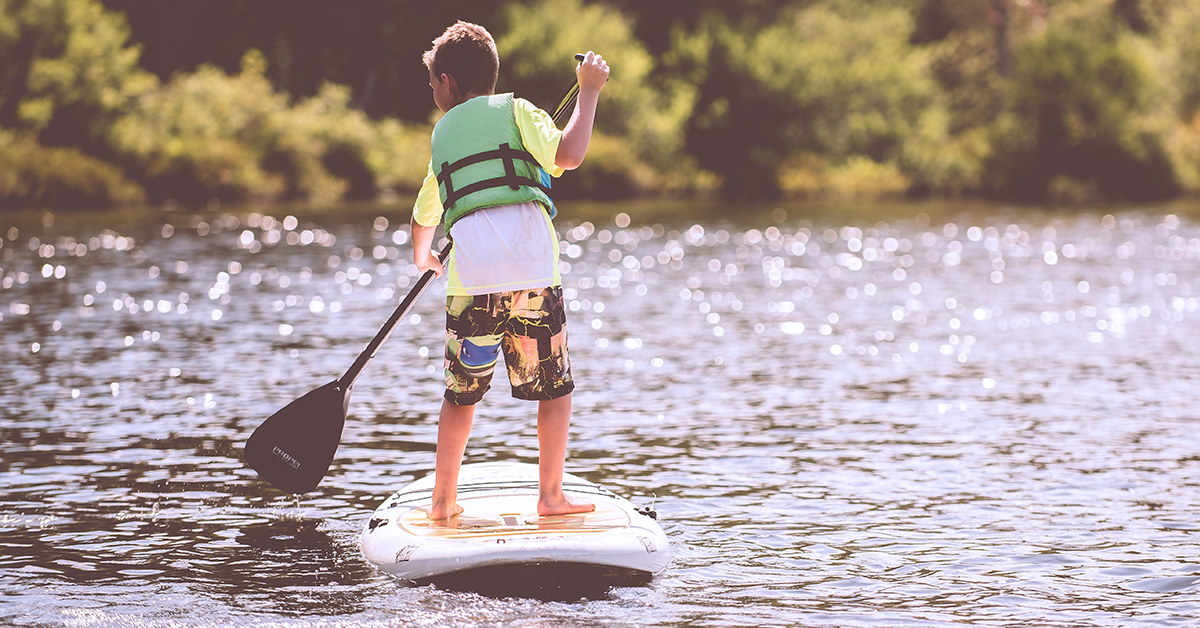
The State of New Jersey requires all children under 12 years of age to wear a USCG-approved Type I, II or III Personal Flotation Device (PFD) while onboard any vessel less than 65 feet in length. This requirement includes non-motorized crafts such as canoes, kayaks, and rowboats. Children in fully enclosed cabins are not required to wear a vest.
This law applies to boaters on Lake Hopatcong boaters because most boats on our lake are subject to this law. Additionally, most watersports on Lake Hopatcong legally require the use of PFDs regardless of the participant’s age. PFDs save lives when used consistently and properly in accordance with manufacturing instructions and USCG recommendations.
Here are some tips and pointers to consider when accessing the condition and suitability of the flotation equipment you have for your child/youth passengers. This helpful guide should not be used in substitution of your independent understanding of state and local laws and regulations.
There are many floatation products, toys, and garments on the market – many are not USCG-approved. All USCG-approved equipment is clearly marked as such. If you do not see a USCG-approved seal or marking on your device - it should not be considered a USCG-approved PFD and NEVER used in place as a USCG-approved PFD. Check for the USCG-approved stamp on PFDs.
A general rule of thumb to remember: if the item is inflatable with an air valve - it should never be considered safety equipment. This includes rafts, mats, floats, towables, arm floats, tubes, and rings among other items.
There are many materials and styles of PFDs in the market. Vests are constructed usually of neoprene and foam. Canister inflatable and hybrid inflatables are expanding from fishing applications to the sporting field. As far as styles, universal use vests are most common, though there are vests and belts designed for specialized activities such as kayaking or water skiing. Regardless of construction or design – all USCG-approved PFDs are classified into “types”.
There are Five types of PDFs - listed as Roman numerals I, II, III, IV, and V. Each type addresses specific environmental/safety conditions and must-have design features to match such conditions. All USCG-approved PFDs have the type clearly marked on the item. If you want more information understanding what each type of PFD means – go to the USCG website.
Children’s vests by law must meet standards for I, II, III types and be marked as such. PFDs with I, II, and III ratings also are required for most watersports happening on Lake Hopatcong.
One size does NOT fit all. USCG-approved vests must be stamped with weight and chest size guidelines. If the end-user of the vest does not match the weight and size requirements of the vest – the vest may cause harm to the child. Check straps and zippers so they ensure a snug fit for your child’s body type.
The USCG website has a simple fit test that you can do to ensure the vest is the right size for your child passenger.
All USCG-approved infant PFDs, child PFDs, and some youth vests have features specific to children. In general, these are the features to consider when choosing a vest:
All equipment can become damaged over the course of time regardless of use. It is good practice to inspect all PFDs at least once or twice a season to ensure the equipment is not compromised in any way. Better yet, check PFDs every time a child wears one. We recommend discarding equipment with faults. Some common faults to look for are:
As with all safety equipment – it is important to be familiar with how the equipment operates. If possible – try the vest with your child passenger in a calm safe and managed condition such as a pool or wading area. These practice runs can help everyone become familiar with the feel, functionality, and specific features of the PFD.
Properly wearing a vest can be tolerated by even the most demanding children. Some of us at Main Lake Market are parents to some finicky kids ourselves! Vest wearing can enhance a child’s ability and willingness to swim or engage in water sports.
If children know that adults will not allow them to boat without a vest, not matter what, they come to accept their part in staying safe. Be consistent. Always have a zero-tolerance attitude. Most children take pride in being law-abiding citizens. You may be surprised how wearing a vest becomes second nature to your child passenger with consistent use and messaging.
We hope these tips are helpful to you. However, they are not to be used in place of your independent understanding of all USCG guidelines and recommendations and the manufacturer guides for your PFDs. Check frequently with Marine Police and USCG for updated state laws and local requirements for your boating destination.
The USCG does not recommend infants ride in recreational watercraft. There are infant vests on the market for the littlest of boaters. Of all child vests, these are the ones that we suggest you test in a managed and safe environment prior to boarding a boat. The fit of these products is highly specific to your infant’s size, age, and shape.
If an infant is on board, consider keeping trips short as body temperature can be affected by prolonged use of a vest on an infant. We strongly suggest that you speak to the infant’s health care professional or contact local authorities and/or the USCG for critical information that may assist you in preparing for an infant on board.
If you are in the market for a USCG-approved PFD for your child passenger, Main Lake Market carries a stock of universal vests in infant/child and youth sizes. We do not carry specialized designs such as hybrids, or inflatable vests for children.


LivetheLakeNJ is a group of hospitality, events and outing businesses that showcase all there is to love about Lake Hopatcong.
Click here to learn more about Live the Lake NJ
234 South New Jersey Ave
Lake Hopatcong, NJ 07849
(973) 663-0544
info@mainlakemarket.com
Thank you for an amazing 2025 season!